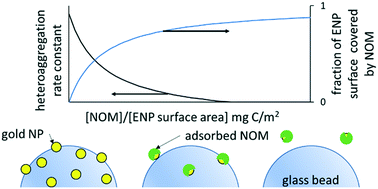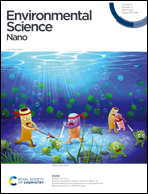Natural organic matter surface coverage as a predictor of heteroaggregation between nanoparticles and colloids†
Abstract
Heteroaggregation and eco-corona formation are important, interrelated processes that transform engineered nanoparticles (ENPs) and strongly impact their fate, transport and toxicity in natural and engineered systems. Yet, there is a lack of mechanistic information linking these processes. This work experimentally validates the hypothesis that attachment efficiencies can be predicted on the basis of the fraction of particle surfaces coated by organic matter. Heteroaggregation between branched polyethyleneimine gold nanoparticles (bPEI-AuNPs) and glass beads (a surrogate for naturally occurring suspended particulates) was examined in the presence and absence of Suwannee River natural organic matter (SRNOM) using a recently developed functional assay. Attachment efficiencies for heteroaggregation were quantified in systems where the relative concentrations of ENPs, glass beads and SRNOM were varied so as to systematically control the extent of eco-corona formation on the particle surfaces. Corona formation on the glass microspheres was negligible, but SRNOM readily adsorbed to the bPEI-AuNPs, reducing heteroaggregation. Measured attachment efficiencies were well described by a model correlating attachment efficiencies with the fractional coverage of the bPEI-AuNP surfaces by SRNOM, providing a promising mechanistic link between eco-corona formation and subsequent aggregation behavior. Further, the dependence of attachment efficiencies on the extent of eco-corona formation reveals the necessity that laboratory-based assays control the relative concentrations of ENPs, suspended particulates, and organic matter such that the resultant eco-corona formation is representative of that expected in the relevant environmental system.

- This article is part of the themed collection: Nanocircular Economy Papers 2014-2022


 Please wait while we load your content...
Please wait while we load your content...
